Dena Hankins's Blog, page 19
July 10, 2020
The Turnaround
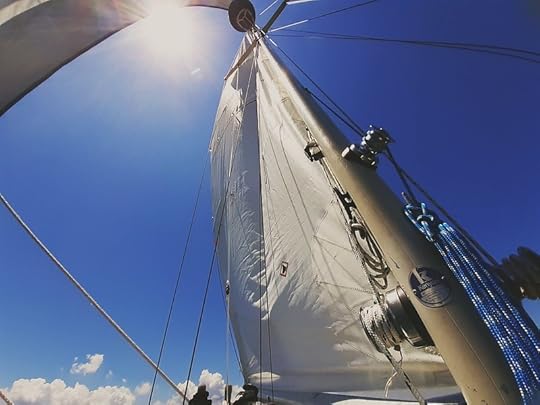
The sail from Holaga Snood off Kent Point to Solomons Island took, well, all day. We were heading downwind and couldn’t quite make straight for it because Cetacea doesn’t have a great big genoa that can be pushed out opposite the mainsail like Nomad did.

We made do.
Again, the trip took longer than the auto-routing function on the navigation app said it should, but that app gives straight-line estimates based on speeds you tell it you can maintain. Slow at times, and taken in long tacks first southwest then southeast then southwest again, we made our way to the Patuxent River’s mouth.
Broad-reaching up the river didn’t last long and we were soon holding our collective breath, waiting to find out whether our usual anchorage was littered with summer sailors.
And, I mean, the answer was yes, I guess. But not so littered that we couldn’t find a space.
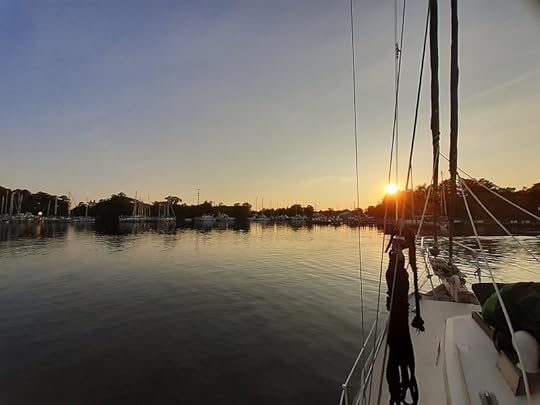
A guy from the nearest boat watched our anchoring process with what I (Dena) thought was undue care until I realized he wasn’t about to opine on our technique. Turns out, he was studying up more than waiting for the gotcha. And his friend started the next day like this:
Lest anyone be confused, I (James) was quick to find out that, yes…he does play Scotland the Brave.
I (Dena) was upset by the prospect of a hot spell coming because…the sea nettles! They were everywhere! Big and small, making the waters look like egg-drop soup. I did some research and found that NOAA’s Ocean Prediction Center has a whole section for predicting the probability of encounters with sea nettles.
The map looks like this:

Do you see what I saw? It would be days…DAYS…before we’d be able to swim again in peace and comfort.
Naw, hon. We don’t play that way.
We also don’t sail on the 4th of July. It’s part of the litany of days-boating-sucks: Memorial Day, Father’s Day, 4th of July, and Labor Day. I can’t wait to get to a country where these are meaningless and we can be taken by surprise by the occasions for which folks rush to the water.
The seriousness of this solemn celebration was leavened by the presence of Glenda Rider. And actually, the entirety of the seriousness and all our solemnity was due to the maskless partiers clumped tightly around the dinghy dock shooting off the big combo fireworks with nary a fire extinguisher in sight. Dancing, trading beers…enjoying a pre-COVID-19 fantasy that just does not apply. It was a display of contempt for rationality and group wellness.
But Glenda? Well worth running that gauntlet.
We left as soon as we could, even though the weather forecast wasn’t certain there wouldn’t be…
I mean, it’s summer in the Chesapeake! Afternoon storms are a thing!
And then with the fifth be-dee-deep-deep, be-dee-deep-deep, be-dee-deep-deep announcement that the weather service had an important message, the storm cell tossing 60 mile an hour winds and quarter-sized hail at Frog Mortar Creek…then Baltimore…then Annapolis…we arrived in Herring Bay and countless small boaters and kayakers and SUPers providing reports of boats flipped upside down and people in the water suddenly became a part of the nervous past because…
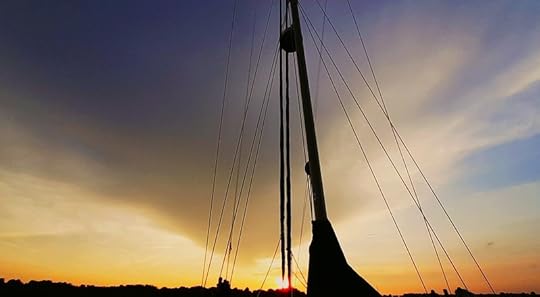
…the storm blew itself out right before it reached us. We anchored safely and swam (because wasn’t that the whole point and wasn’t it lovely to cool off?), had a bit of a rough evening, but were safe. We were safe and in love and all was well.

July 1, 2020
Pointing to Holaga Snood
Harness Creek was kind and gentle on everything but the dinghy. When we felt the bottom of the dink, it was furry and tenacious like a lime-green shag carpet, cir. 1974!

Time to weigh-up and move on.
We sailed down the South River to Galesville to get eyes on a cool little marina Dena applied to run a while back and of course bite into some local seaside vittles.
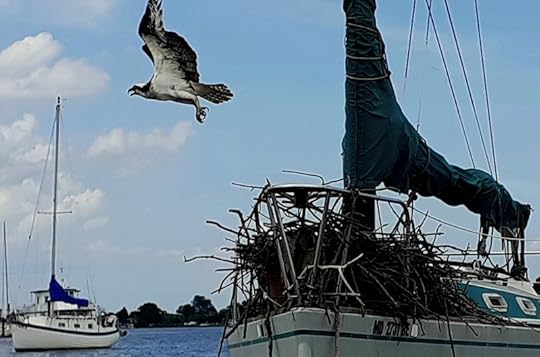
We only stayed the night, it was awesome. Very shallow, lightly trafficked. If you don’t need anything ashore, the little bay off Hartge Yacht Harbor is cool.

The next day we decided to take the favorable winds across the Bay to the Eastern Shore, up the Miles River to the little town of St Michaels. The sailing was spectacular on all points of sail and the new solar system performed like we built it to: silent and strong.
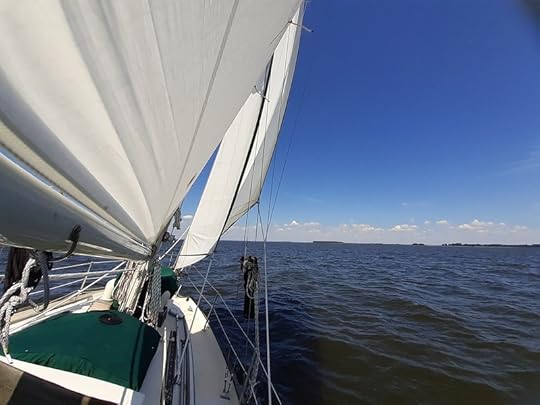
We spent two hours more than the best estimate getting up the river because, well, we could. Why rush when you can sail? It was the kind of beating that never was much fun on Nomad, but which Cetacea takes to happily.
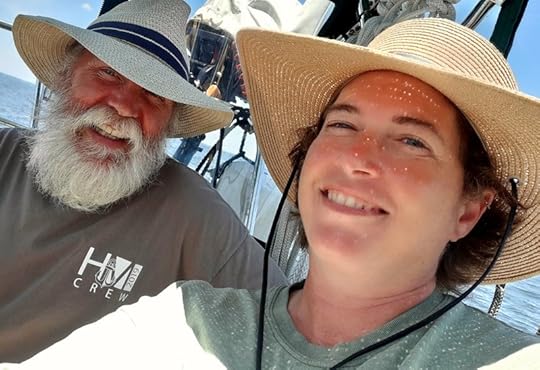
Our brains on sailing
Upon our approach to the deep water anchorage just outside of the town mooring field, we made the shocking discovery that our #1 Jib, the “Yankee”, was stuck. It wouldn’t roll in more than a little. When I (James) went to pull the sail down, I discovered that it wasn’t just suck in the open position…it was stuck in the up position as well.
Not only an annoyance but extremely dangerous.
Just imagine sailing in the ocean and the winds suddenly kicked up like they are prone to do, then you discover the sail is stuck open and full with no way to get it down! That’s kind of like heading into a brick wall with the gas pedal stuck to the floor.
Well, in the moment, I pulled the sheets off the sail, wrestled the sail around and around the forestay, and tied it to the furling drum. That got it out of the way so we could anchor safely before tearing into the roller-furling system’s mysterious betrayal.
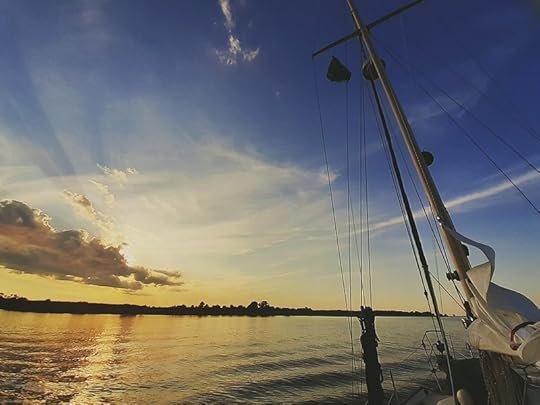
After a full day of active, up-river sailing, heroic temporary measures, and finally working the sail down once we could both focus on it, we came to the conclusion that rebuilding the roller-furling system would be better left as a project done fresh in the morning, after coffee.
That night Dena pulled out all the literature we have aboard on our twin roller-furling systems, matching Furlex 200-S, and scoured the installation manual for any hints on what we’d be getting ourselves into the next day.

One of the many reasons we bought S/V S.N. Cetacea was because she had many familiar systems aboard…like the Furlex 200-S, the same roller furling system we had aboard S/V S.N. Sapien that never failed, even crossing the Pacific Ocean to Hawaii.

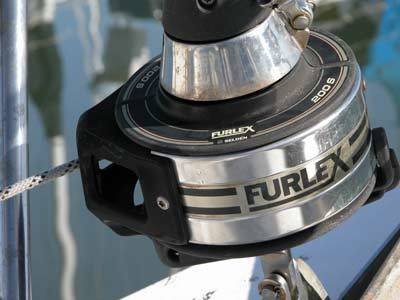
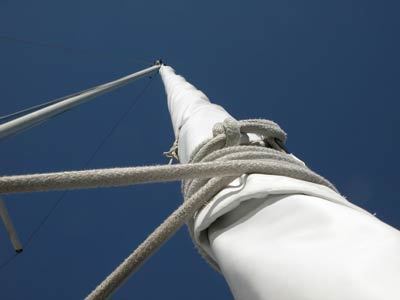
Sapien, however, never had such a collection of half-assed previous owners.
Raising a sail on a furling system means lining up a thin rope (called a luff tape) sewn to the sail with a channel in the track that goes up the forestay (the luff extrusion). As you pull up, the luff tape slides into the track and the sail rises, held all along its length by the luff tape in the luff extrusion’s track.
Our yankee had a stainless steel “pigtail” almost 2 feet long (a wire that extends the halyard length to the top of the mast) that connected the top of the sail to the halyard swivel (the piece that pulls the sail up and also allows it to spin and roll in). This pigtail allowed the halyard swivel to hit the top guard every time the sail was raised, lowered, eased, tensioned, etc. The top guard eventually popped right off the top section of luff extrusion, screwing-the-pooch by a half twist.
This is where it got dangerous. The luff extrusion sections are held together by connectors that simply pop into place. A somewhat slack forestay allowed the whole thing to flex enough that the luff extrusion section at the top popped out of place…and when it became misaligned with the one below, the halyard swivel couldn’t descend.
We’d gotten the sail down by a combination of bouncing the halyard swivel up and down and flinging the sail itself this way and that. In the kerfluffle, the top section of mast extrusion somehow (magic?!) found its mate and lowered just enough to hold itself in place…as long as we didn’t make it bounce.
The bolt-cutters came out and the pigtail went away. The sail went back up smoothly and didn’t mess up either the top section or the top guard, meaning we could roll it up safely.
Meanwhile, we also took apart the bottom swivel looking for any further problems. I (Dena) was in the dinghy to catch flying fasteners and parts, but we’d anchored near the line between the red for St Michaels and the first red for a river bend…meaning we got waked vengefully by all the power boaters who didn’t want to keep their speed down for even another three minutes on the way out.
At some point in her (many owner) past, S/V S.N. Cetacea clearly lost one of the fasteners inside the barrel of the yankee’s Furlex. When we pulled the barrel apart, I saw that one of the fasteners was different than all the others. Someone had done a seat-of-the-pants repair and failed to go back with the right fastener. Not only was the bolt a hex-head rather than pan-head, it was too long and snagged the furling line inside the barrel when under a load. We pulled out our stock of fasteners, replaced it with a shorter philips pan bolt and…
Holy-Shit, we fixed that bitch!
The problem wasn’t just a stupid bolt or a too-long pig-tail or a fouled foil on a loose backstay. It was the perfect combination of all three being under load on all points of sail that ultimately caused the failure.

The other side of the entrance was less bothered by powerboat wakes, but I (Dena) got my first experience of a sea nettle sting. What a drag! Their trailing bits are long and diaphanous, which means a single sea nettle can swathe an entire arm in a split second. This place wasn’t winning me over. And then we discovered that they don’t even stock Kraken locally.
By the time we left St Michaels, we were convinced the town was suffering from the same dismally desperate failing capitalism that is killing our pandemically pounded populace.

Best put that newly fixed furling system to work and sail away.
 Four anchorages in four days
Four anchorages in four daysIf you know anything about us, you know we like to keep the hijinx to a minimum. When I (James) got the news that my best friend had taken his own life, we made it a short day, putting the hook down at Holaga Snood on the tip of Kent Island.

Goodbye Arik, I’ll miss you!
…Then we went sailing!

June 20, 2020
Rebuilding the Solar System

When in the course of human events it becomes necessary to destroy a system that no longer works, not just efficiently but at all, the only obvious progression is an absolute and total rebuild, from the waterline up.
Any system, whether it be political, jurisprudential, technological, educational, transportation, sociological, microbiological or whatever…when it’s broke, you gut that sucker and start anew.

When we first moved aboard S/V S.N. Cetacea we knew we would need to rebuild some of the systems in our little world. We just weren’t sure what was going to reveal itself as an ‘absolute necessity’ first or in what order fails would ultimately occur. So we made our systems-priority-replacement-lists according to our immediate needs as cruising sailors.

For example: ground tackle. The boat must stop when you want it to stop! The boat had a decent anchoring system aboard when we got her but it wasn’t what we considered an adequate system for the kinds of anchoring we do, therefore, gut that fucker and make it right!
And that is exactly what we did! We kept the totally awesome CQR. We ditched the 50 ft of shitty old chain and replaced it with 200 feet of BBB 5/16. We also ditched the stiff old three-strand for some fancy brait that takes up less room. Yes, we sleep very well at 10:1 with a 15 foot snubber, thank you!
When the time came to implement the cascade of changes necessary in order to start using the Monitor windvane (the best helmsman we have in our crew), we would accept nothing less than perfect access to the tried and true system that has never failed us. Flipper, Cetacea’s Monitor, has never had the opportunity to fail us, buried as it’s been below the combination of dinghy davits and solar panels.
First, move the solar panels. Easy enough with the clip-in connectors that combined the two panels and sent all the power to a single solar charge controller.

The ridiculous way they’d(previous owner, of course) installed the solar panels made them a pain in the ass to remove and a pleasure to have off the boat. We got that entire mess off the back of the first panel and installed it on the aft section of the bimini cover. Since it was edging close to knock-off time, we decided to simply hook the electrical back up with one panel in the new home and one still in the old.
But wait! Why, on reassembly of the connectors, does the charge controller no longer provide any signs of life?
As practiced electrical system diagnosticians, we dove into the questions and ruled everything out except…dead charge controller. Now, killing one of those things isn’t the hardest thing to do, but I (Dena) had downloaded a manual so I’d be sure to disconnect and reconnect everything in proper order.
Regardless. Off on a bike ride to get another charge controller 20 minutes before PKYS closed, debating the idea of separating the two panels and sending them to individual charge controllers…eventually.
When the thing had been bought and fetched, I tried again to get rational information from the multimeter about our solar situation and realized…the connectors had come apart inside.

Dead gear
Whoever fucked together the mounting system also failed to protect the connectors from corrosion with dielectric silicone. When we’d pulled the connectors apart, the cupped part had been more firmly attached to the pin than to its own wiring or fitting. Dead dead dead!

So much for simply moving a working system. And so much for maintaining the combined version of the system. We needed, yes, another charge controller. A second visit to PKYS and some judicious chopping of wires, and we were charging powerfully.

Good gear
Once both panels were repositioned, rewired, and recontrolled, our solar system started working like nothing we’ve ever seen…because we traced every single electrical lead and replaced every single connection that was even a little suspect as being corroded or contaminated in any way. We gutted it and fixed every broken piece of the chain of connections all the way to the very top and because we did that, it works perfectly!


 When clouds pass between the solar panels and the sun, the output changes dramatically.
When clouds pass between the solar panels and the sun, the output changes dramatically.Now we live in a brand new solar system. We recycled what we could we re-use every thing we can and we always… live… happily ever after (non-metaphorically).


June 11, 2020
Sailing the Seas of Eastport
For the past few months (since before we got back in February) we’ve been piling projects up on our “when we get to Eastport and haul the boat” list. We had put together everything we’d need, but ended up storing it all for later…bottom paint, rollers…all of it!
You see, it was too cold in Warwick, Rhode Island, at the beginning of April to apply the chemistry we need on the bottom of the boat. It has to be at the very least 50 degrees F and it never got above 40 the entire time we were there. As a matter of fact, it didn’t get consistently above 50 for us until we got to the Chesapeake Bay!

All those layers and I was still chafing my cold hands together.
It was a long cold spring for us. That was after spending the winter in Kerala’s steaming jungle so we weren’t quite up for the work of a haulout until it got warmer…much warmer.
We even took a side trip to one of our vacation homes…the bight past the shoal in Mill Creek.

More brown water
It was our favorite easy destination when we both worked full time in Annapolis. Close by boat, far by land, and we never, ever saw any of the slipholders while we were dockmasters.

So by the time we sailed into Back Creek in Eastport (of Annapolis, Maryland), S/V S.N Cetacea was showing the signs of a well used traveling vessel.

That brown beard around the waterline of the boat is caused by tannic acid in the brackish waters of the eastern seaboard of North America. If you travel by boat within the protected waters of the US East Coast and you have a vessel made of gel-coated fiberglass, your vessel will get stained brown as shown in the photo above.

Because the acid doesn’t cause any long term damage most hardcore travelers like us wear the “Tannic Beard” with pride. It shows the people-in-the-know just how much of a cruiser you are. But there comes a time when you gotta grit your teeth and “git-‘er-done”.

So we started with the topsides. I (Dena) have been lecturing people on how to use On & Off for years and years, but I had never used it myself until now. It’s safe for gelcoat, but strips stains (and wax) like nobody’s business. The main ingredients are hydrochloric, phosphoric, and oxalic acids, and oddly enough it is neutralized by rinsing with fresh water. Easy enough, but I’m the geek who actually read the MSDS and that shit’s for real.

Most of the past haulouts we’ve done (15 in all) have started with the projects below the waterline, but the On & Off is too harsh to put off. As soon as that chemistry was done, though, we moved on to seacocks.
The most crucial aspect of any boat is that it floats, so any hole in said boat is a big damn deal. When replacing seacocks, we’re exposing a hole in the boat that is always there, but well stopped-up by some combination of valve, base, etc. When the new seacock goes in (we’re replacing old bronze ones with new Marelon that isn’t affected by electrical current in the water), it has to go in perfectly. The valve won’t keep the water out if the water can squeeze in around the mushroom (which is on the outside of the hull) and avoid the valve altogether.
It’s not even that complicated. A combination of devil glue (AKA 3M 5200) and screwing the mushroom tightly into the body of the seacock takes care it. If assessing the risk based on likelihood of failure in ratio with the severity of the consequences of failure, the intensity is purely on the consequences side.
We’ve been having engine trouble. (Fuck, I hate that sentence.) Several times, when restarting the engine after sailing for some hours, the engine has failed to put out water in the exhaust. The first time, we were sailing to Old Saybrook. When it happened twice more, we were tearing our hair out.
Eventually, it became clear that, somehow, air was getting into the system. It was either a split in a hose or the gasket on the raw water strainer. This problem was compounded by the fact that our intake didn’t have a scoop on the outside (just the mushroom you see above), and the rushing of water over the hull created suction that pulled air into the system from whatever was leaking. There’s a word for the effect this has on the raw water system: airlocked.
We’d hoped to simply replace the mushroom with a scoop strainer, regasket the inside strainer, and check the hose for leaks, but when has anything ever been that easy?

Frankenstrainer: this is not okay.
Instead, we removed and upgraded the whole seacock assembly, added a new-to-us bronze strainer, and replaced the hose from there to the water pump.
Getting to the whole set-up from inside the boat meant clearing one lazarette, removing a group 31 battery, and still I (Dena) was working with the ends of my fingers to get the seacock in place.

That tiny bright spot in the lower right of the frame above is the hole where the seacock goes.
One of the cool things about reading a blog is that you, the reader, don’t have to do the things we did. You get to watch.
That shit was hard and it took a long time (during which we also did the bottom project) but we nailed it. I (James) went up and down that ladder 41,000 times, Dena went in and out of that lazarette 10 million times, and we did the job right the first time.

Not only does the new system work perfectly but the entire cooling system is now easier to work on if needs be. That Vetus hose is a miracle of flexibility.
The bottom job was ordinary: griddle brick with water, wipe down with Interlux 216…

…and apply paint until two gallons are transferred from the cans to the boat.
An unexpectedly seized seacock in the head meant a last minute project addition, which put us one day past our planned launch but also gave the paint a nice long time to dry. Since the bottom paint we’re using is water-based, it’s the opposite of the kind where you have a max time to launch…our minimum time was 16 hours.

Because we rock, the last night of haulout-2020 was a wonderful relaxing evening in the cockpit overlooking the mouth of the Severn River to the tune of a beautiful Chesapeake sunset.

As we looked out across that calming scene, we reflected upon all of our previous haulouts.
We’ve hauled out at the Wooden Boat School in Port Townsend, Washington; Canal Boatyard in Seattle, Washington; Point Roberts Marina in Point Roberts, Washington; Bay Ship in Richmond, California (three times, two different boats); Little Creek Marina in Norfolk, Virginia; Cutter Marine in Middle River, Maryland; Norwalk Cove Marina in Norwalk, Connecticut; Yankee Marina in Yarmouth, Maine; Wharf Marina in Warwick, Rhode Island; and of course twice at Eastport Yacht Center in lovely Eastport, Maryland on S/V S.N Nomad and…

S/V S.N. Cetacea!

So yeah, sailing the seas of Eastport was a difficult and uncomfortable adventure for sure but this process is part of the life we’ve chosen to live. It’s a chore, albeit a lofty one, and as long as we take it together, one explosive tragedy at a time…it’s all good!


June 2, 2020
Charm City Lament
Baltimore, you smell funny.

That lightly diluted chemical that fills your Inner Harbor is not water and it hasn’t been for a very long time.
It sinks my floating dinghy line and smells of…
I (James) just sighed as if I was trying to pay attention to another non-fight scene in West World.

Oh Baltimore I love you but you smell funny goddamnit and I can’t define it!
Oh, there’s some sulfur in there, sure, and maybe a little condensed anger mixed with urea and gasoline…but, there’s also a hint of brilliance augmented by a powerfully large dose of the oxide twins, Carbon-Di and brother Mon. I believe there’s a smidgen of plastacine interwoven with a seemingly non-stop supply of the worlds largest floating condom species. But that still doesn’t quite define that smell.

Baltimore, I know you, I lived with you for a hell of a long time, for me, and I think you’re pretty awesome most of the time. I made some money, some friends, some knowledge and some skills in your urban-sprawl but that funk, that smell, that putrid waft of concoctions-unknown, is what I ran away from, and that shit, emanates from your Inner-Harbor… maybe ‘funny’ isn’t the word I’m looking for here.
That poor sad sickly soup that is so not funny somehow remains your life’s blood all the while showing us the unimaginable tenacity of life with the simple act of a tiny leaping fish.
Every time we weigh anchor your harbor blows forth gifts, or hints rather of your unique odoriferous contributions to our environment and never fails to inspire us to run, once again.
…Poor dear Baltimore
There’s always the plastic bread-bags and the wad of hook-riddled fishing line dripping from the oily bottom muck but every once in a while a tiny gang of krill will burst forth from a discarded milk jug or a rusty can of beans reminding me that we really can’t kill everything in the world…unless, of course, we try.

Even though we always run, we always return with hope that someday life will win again in your life’s blood and your smell won’t be such a complicated riddle.
Till then, ew!

May 29, 2020
Fade into Bay
Chesapeake City rained a little, gusted a bit and all the boats in the anchorage drug-down on their anchors… all but one, of course…us!

One plastic-destroyer skipper actually motored up to me while I was quietly sipping coffee in the cockpit and asked me to “give him a little blast of the horn” if I see his boat dragging.
Even though the name of their boat was “M/Y Morning Prayer” and they were asking a complete stranger to babysit their blessed motor-yacht, I wasn’t belligerent at all. I simply smiled, nodded once and forgot he ever existed.

We quickly recovered from our forty-one-hour blow-out tour of New York, the Atlantic Ocean, the Delaware Bay, and the C&D Canal. So, once T/S Arthur had blown himself out without ruffling our feathers much, we wasted no time weighing anchor and pointing the bow up the Sassafras River.

I think this might be the best photo anyone has ever taken of me (James).
Photo by: Dena Hankins
In quick succession we sailed up/anchored/sailed down the Sassafras River over the course of two days and then went to discover Perryville and Havre de Grace (though the museums that make it a possibly-cool stop are all covid-closed). It’s a couple hours up the Susquehanna, which I (Dena) have read a lot of historical novels about. Just past the flashing red-over-green buoy “A” where we took the north fork, I checked the hours at the post office and got a shock. “Hours may be different on Memorial Day.”
Gasp!
How could it be Memorial Day Weekend?

Georgetown, Md.
My (James’s) father used to say, “There are only four days a year a ‘real sailor’ can’t be caught on the water: Memorial Day, Father’s Day, 4th of July and Labor Day. Those are the days the dumb-shits and assholes take over the American Waterways. Best stay at anchor!”
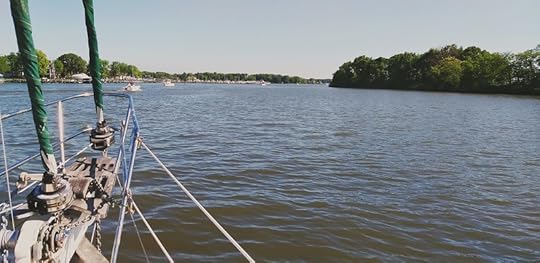
All the way up the Sassafras River, Georgetown, Md.
…sound advice, but a little late for that. A popular and questionable destination with wake advisories? We didn’t have to be that oblivious. We made a hard turn to starboard and sailed slowly behind Turkey Point, barely up the Northeast River. Hook down and the four boats in that little bight all left before sundown.
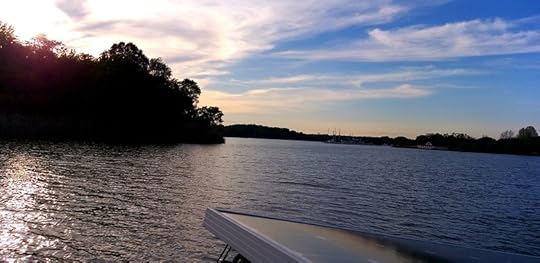
Frog Mortar Creek, Md.
We sailed to Middle River and up Frog Mortar Creek on Monday, hoping that we’d arrive late enough to miss a good deal of the holiday traffic.

Well, that didn’t work out. We got to anchor where we wanted, so not all was lost, and the weekend was wrapping up…or so we believed.
This year is different. It’s the Covid19-Memorial-Week-Fuck-Off and on that Tuesday during the C19MWFO, every single asshole in a power-boat within 10 miles of us had to come by with their trump-flag-a-fly’n to give us a wave and a wake.

American Author, Dena Hankins takes the first leap of 2020
Then we made for Baltimore, where we are now. It was a windless engine drone of an adventure that is hard to want to write about but the only way to properly approach Charm City, I’m telling you again, is by sea.

Francis Scot Key Bridge, Baltimore, Md
The city of Baltimore rises to you as you approach and the intensity doesn’t stop with the boat, it just becomes part of the overall ambiance, and we are immersed in this crazy industrial atmosphere.

Baltimore, Md.
…on our tiny Sovereign Nation, S/V S.N Cetacea @-Large.

May 19, 2020
Somnium
In the dream, the feelings, sensations and levels of stimulus on a sailing adventure that starts at 4 am in Long Island and ends one day and seventeen hours later in a hurricane-hole 209 nautical miles away in Chesapeake City, is real. But in reality, “…this is how WE do it, baby!”
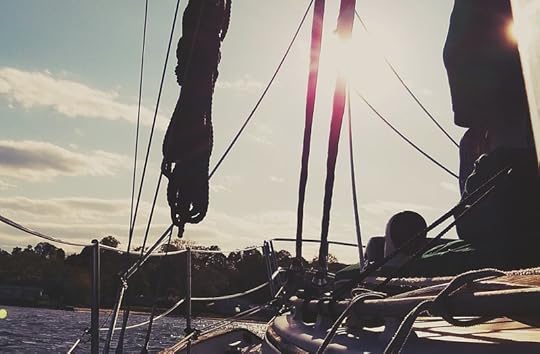
We left Manhasset Bay with excitement. It’s a good staging spot and all, but we’d been there too long. Our anchor was caked with the thick mud of the southern end of the bay and even the anchor snubber showed signs of having dragged around in the muck.
The dinghy stowed surprisingly well on deck. Even pushed forward far enough to sit as low as possible, it was easy enough to move around behind the sampson post. The two sides hugged the dorade boxes in an as-though-made-for-this kind of way, and the lack of motion in a pounding (foreshadowing, anyone?) was gratifying.

The entire trip down the East River to the Verrazano Narrows in a little under 4 hours. That’s around Rikers Island, through Queens, The Bronx, East Harlem, Brooklyn, Manhattan and Staten Island…all of New York City before lunchtime and we still hadn’t reached the Atlantic Ocean.

Our top speed for the entire trip was entering the East River at Hell Gate doing 10 knots on glass water but we never got under 7 knots all the way through the City. We were doing a respectable 4-5 knots as we were disgorged by New York Harbor.

All sails aloft, a broad reach off the Jersey shore took us into the maw of the Atlantic Ocean.
From Sandy Hook on a freshening ocean easterly, we watched the local star burn the beach inhabitants two miles west of us for most of the day. The ocean swell was from the southeast and the winds were increasing at east-northeast, giving the seas a random jumpiness like riding a pachyderm on rocky terrain…a really big pachyderm. But as the continent fell away to the west, we maintained the lubber line that took us further from the lee shore and into the night.
Night descended on my (Dena’s) watch. The blaze of reflected and refracted light dazzled me, but we were alone on the ocean and I had no need to be overly attentive in that moment.

We do one hour watches throughout the day and three hour watches overnight from 9 to 9.
I (James) got the odds-watch, 9 to 12 and 3 to 6, so when I stepped to the helm (out of a deep sleep) at 2100, I saw the moonless dead of night off my portside and fucking Atlantic-fucking-City to my starboard buried in the post-glorious hues of an afterburner sunset.
I like for my eyes to get adjusted with the world of nighttime sailing but being only 6 miles offshore from Atlantic City never gave my eyes the opportunity to adapt to true darkness. Also, there was spooky traffic on the water for the first couple of hours. At one point a boat did a perfect one-mile circle around us to the right. They showed me only their starboard running lights…in the ocean…at night…I think that’s weird. Must’ve been a cop.
I (Dena) took over at midnight after three hours of failing to sleep. I rested as best I could, but once I was at the helm, it was all about scrounging energy from the recesses of my being. Luckly, the winds had gotten just strong enough to solidly surmount every set of swells (and require a reef in the main). As the hours went by, I steered less and less, until I realized that I did more harm than good interfering with the boat’s trajectory.
The sails balance to make steering easy if you’re trimmed right, but weather helm is a factor that’s designed into boats. It means that, uncorrected, the boat will turn its bow toward the wind. It’s a bit of a safety feature, slowing it down every time the boat turns up far enough to flog the sails and making it more likely that a fallen-overboard skipper can swim back to the boat.
The slow, swelling 3 to 5 foot waves were rolling at us from slightly forward of the bow, which shoved the bow away. Rather than correcting the weather helm by steering slightly off the wind, I steered slightly into the waves. At first the effect was so light that I didn’t even need to engage the wheel brake…the whole interaction was self-correcting with the rudder moved by the waves and and the sails kicking the bow into the wind when the boat veered to far. Finally, the waves got just far enough behind the beam that I locked down the wheel brake and we continued on, the boat driving herself.
Beginning my (James’s) 3-to-6 (dog) watch, I discovered that Dena had dialed in the reefed rig and we were clipping along at 5.8 knots, hands-free! As a matter fact, for the first 45 minutes of that dog I never even touched the helm. We were perfectly balanced and grinding through the seas with an almost vengeful hiss. That’s when the moon rose from the hazy black beyond. Dressed in her most dramatic red-orange waning crescent, Luna pulled herself out of the ocean like a hook from a finger then paled and dominated my imagination for the rest of my watch.
Sweet sleep! I (Dena) had managed a good solid amount in the three hours since I’d last been responsible for shepherding 12,500 pounds of boat through wind and waves. The sun had risen, this being 6am, but it wasn’t certain whether to shine or hide. The seas hadn’t grown much, but they had gotten sharper. We were approaching the shore to get on a proper approach for Cape May, and faster, meaner waves showed us the frustrated power of the ocean with both wind and swell driving toward the shallows. The entire Atlantic Ocean represents quite the fetch.
I eased in and the main blanketed the yankee. I turned back out and the waves slapped the quarter and sent us reeling. Poor James, trying to sleep through a rodeo ride. Finally, I rolled in the yankee and we downwinded on main alone. This allowed me to smooth the ride a little, and it sent us toward shore at a good clip. The motion was exhausting, though, and I simply wanted to get that portion of the trip over with.
The next time I (James) registered consciousness, I was at the helm driving a tight curve around Cape May, New Jersey with a sweeping following sea attacking the hull at ascending angles as we rounded up into the Delaware Bay.
Ah, the Delaware Bay…
The first time we sailed this body of water was the summer of 2012 and it was no less dramatic than it was yesterday.
Back then, we were heading down-east with the boat pointed at the Hebrides. We came out of the dreamy calm of the C&D Canal right into the bite of that year’s first “Named Storm”, Joaquin.
I had been listening to people whine and moan about how terrible the Delaware Bay was for the two years prior in the Baltimore sailing community so we’d gone into it with gritted teeth.
And that was a good thing I believe. Psychologically it paved the way for us to survive a pretty bad storm and it set expectations for future experience.
For example: yesterday!
Now this is the part where I get to talk about how great a navigator Dena is!!!
Remember last year when we sailed from 79th Street, Manhattan around the Island to Manhasset Bay on a single fair current?
Well, on this last adventure Dena plotted a course that took us all the way from Manhasset Bay to Chesapeake City, MD, with only one foul current (off the Jersey shore where it had little to no effect on our overall speed average.)

Four states, two bays, one ocean and one river with only a single foul current that we didn’t even feel…brilliant!
Well, thanks, James! It was a near-run thing because we got to Cape May a couple hours earlier than I’d thought likely. The current was barely turned around when we got into the Delaware, hoping for a respite from the wild wave action we’d experienced for several hours. Of course James already said…we don’t expect it to be too easy.
The less said about the lower Delaware, the better. By the time we reached Ship John Shoal Light, the chop had begun to lay down considerably and the navigable water narrowed.

We entered the Chesapeake and Delaware Canal as the sun was extinguished in clouds, and the fast passage under bridges and to Chesapeake City was noteworthy only in our forcibly intense attention. Entering a narrow channel in the dark with a 2 knot cross current that would die abruptly is even more fun in the dark, but we managed without too much stress. We dodged the boat that had chosen to anchor between the marinas and moved to the more-open east side of the little cove.
Hook down, we settled the boat, covered the main, toasted each other with rum, ate fried egg sandwiches, and went the hell to bed.

May 7, 2020
On Main Alone

Days of gales at anchor, a wild ride in a monster truck (up and down the Eastern Seaboard to get our bikes to Annapolis)…

…and some clever social-distancing from some good friends defined the blur-of-a-memory that was our Covid-Old Saybrook-2020 adventure.

That’s S/V S.N Cetacea over Fred’s left ear and Sue’s head.
Then we went sailing!

Once again the spring guided our departure with a narrow window of fair winds. The weather said it would start slow and could get gusty with winds at 10 to 15 knots from the northeast, setting us up for a down-wind run west from the mouth of the Connecticut River.

I (James) figured we could go nice and easy by tightening the tack for a reach to Port Jefferson on Long Island, and that would make for very little high-jinx and a nice short (ish) day. This is a thing we’ve done a few times so not really an adventure, just a sailing trip.
But,
The last time we went to Port Jeff was a miserable anchoring experience. We dropped the anchor on the fingernail edge of a large expanse of safe water completely full of empty mooring balls! Our motivation to spend two and a half hours navigating into and another couple hours coming back out of a place we don’t even like was almost nil, the weather was only starting to kick up, and by the time Port Jeff was off our port bow, going there wasn’t even a thought.
So we pushed on.
We had a window of less than 24 hours of downwind sailing before another strong southwesterly would mean banging our heads on the wind and waves, after which another rocking Nor’Easter would blow through the Sound. That and the fact the current would be fair for a little more than half the trip inspired us to choose the “Incredible Adventure!!!” option. We sailed the whole Long Island Sound in one go.
We totally kicked it’s ass and ran the length of the Sound in thirteen hours. It was a wild ride.
We weren’t quite directly downwind, so the one-foot-or-less wave-height (lie) would have been (sigh) nice. Every time we got hit by another five to six foot growler from abaft, we heaved and rolled…still not enough to scare us out of pushing on. A portion of this bravery was due to the moment when I (Dena) said, “Hey, I’m going to take some meclazine…want one?”
By the time we got to Halfway Rock Light (vid below) the tide had turned around against us but the winds had increased.
This gave us a solid run with a full mainsail for 12 of the 13 hours we were underway. We never even unfurled the headsails or reefed the main… One tack, on one heading (M-260) for 12 absolutely invigorating hours straight down the middle of the Sound was only broken when the wind died right at the worst of the countercurrent. We ran the engine for an hour on and off, milking the wave action to keep the minimum speed necessary to control the boat, but the rest was silent running.

We grabbed a free town mooring in Manhasset Bay a little after 1900…Then we lit a fire and all was well in the world.

May 5, 2020
Jump
When the weather says ‘Jump’!
We woke up, looked at the weather, weighed anchor and were underway, just like that, after three weeks of feeding the fire and foraging in Covid-New England.

Sailing south down the Narragansett with the wind and the tide was a brisk New England sleigh ride but the temperatures rose along with the wind all day long, making anchoring in Point Judith Harbor of Refuge more like a nice gentle trip down memory lane than a sailing adventure.

You’re not getting any complaints from us!
With a 48 hour weather window going our way, we jumped all right and our timing couldn’t have been better!
Day two was an easy start on rolling glass with the fair current but as the ripples rose so did the dacron and sailing did ensue.

By the time we got to The Race heading west into Long Island Sound we were doing 7.1 knots on the regs and S/V S.N. Cetacea was in her element. She was dug down deep in the washing machine chop throwing a growling hiss off her waterline with nary a heel to lee.

We hugged the shoals to north passing the Thames and Niantic but soon the twins at the mouth of the Connecticut rose from the direction of our next descending squall.

The current angled as we entered the river’s flooding pull and the winds got fluky, like they do, so we rolled in the headsails and started the diesel.
Fuck-n-A! No cooling water coming out of the motherfucking exhaust pipe! Shut her down before the engine overheats!!! “All technology fails!”*
James was at the helm so I (Dena) rolled the yankee back out. The staysail is too easily blanketed by the main when we’re running, and it looked like we would have to enter the river under sail, downwind and down-current. With the current branching at the breakwater walls between the up-Long Island Sound current and the up-Connecticut River current, there would surely be a strange crossover point where the river would take over from the Sound.
As James crabbed us toward the narrow gap between the two rock walls protecting the river entrance, we discussed our options. There was the nervous entrance channel to be navigated, but then would we be able to make it into the much narrower secondary channel into the Old Saybrook Harbor of Refuge?
Not a good bet, especially since picking up a mooring under sail is something we’ve practiced even less than anchoring under sail.
Instead, we decided to anchor at what is basically a wide spot in the road…an area just outside the river’s channel and supposedly 9 feet deep.
The up-Sound current pushed hard against the side of the boat, and we were traveling almost 40 degrees farther west than where the boat was pointed. I milked every bit of wind with the yankee, holding it tight when it wanted to flap and letting it fill when it could. Finally, as we lined up with the rock breakwaters and the currents began to switch on us, James was able to turn us that last crucial bit into the wind so that we had firm control.
Had the wind died just then, we would have been at the mercy of the current and it almost certainly would have smashed us on the rocks.
Instead, the wind stiffened up and we sailed with confidence through the narrows on a tight reach.
I took the helm and James went forward to ready the anchor. Sailing into shallows calls for alertness and patience. I wanted to make sure we wouldn’t settle back on the anchor far enough to end up back in the channel, but I also needed to know that we weren’t going to end up running aground. James’s job on the bow was to wait until I said to drop the anchor and he had the hardest part. Waiting is always the hardest part.
I was waiting too, coming up into the wind to kill my speed and then falling off to get a little more. The range rings showed a better and better distance from the channel and a less and less luxurious distance from the shallows, but the depth just wouldn’t drop. Where was the bottom? I eased in, farther and farther, testing James’s patience and my own, before I decided that we’d better get the anchor down.
We were still going almost 1 knot when I said, “Drop the anchor,” and I tried hard to both round up into the wind to kill speed and not actually tack, because tacking would mean raking the chain across the bobstay. Instead, the chain raked the hull and much wincing commenced.

The anchor symbol in the orange circle above is where we stopped.
As soon as I was confident we weren’t moving, I jumped down below. Got out a new impeller. Retrieved all the tools I’d need. Cleared space for the engine cover. Pulled the water pump off the engine and removed the face plate.
James had been accessing and shutting off the seacock that fed water to that pump, so only some of the water in the engine flowed out. And then I saw…a perfectly intact impeller.
Damn it! If it wasn’t the impeller, what could it be?
James eased open the seacock and water poured from the pump housing, so that wasn’t blocked. I put the whole thing back together and…the engine was fine. Plenty of cooling water coming out with the exhaust. It must have been a bag or a jellyfish or who-know-what blocking the raw water intake but not so firmly that it didn’t disappear between the bad start and the good start.
In both “what the fuck” and “that’s great” fashion, we celebrated briefly before hauling the anchor and hauling ass into the protected area we’d looked forward to since those nasty northerlies in East Greenwich. Because yes…the wind had continued rising and a small craft advisory had been issued. We went from not-enough to too-much wind in about an hour.
The Old Saybrook basin is well-dredged and we’ve picked up both town moorings and yacht club moorings in the past. This time, our rather shocked eyes beheld a basin devoid of moorings and oddly spacious. We pulled right up a safe distance from the town dock and anchored with our usual enjoyable precision.

Safe.
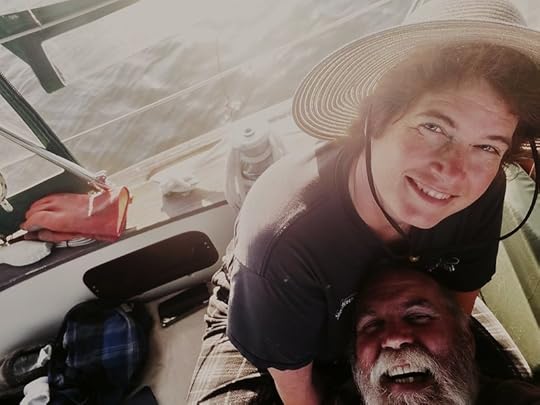
I (James) have no idea who I’m quoting here but there’s never a truer thing been said.

April 21, 2020
The gales of an isolated spring

The thought of riding out another southerly gale in the middle of Knock Down Alley between Dutch Island and Jamestown felt like a long growling sigh, grrr-argh!
But Sunday was the quintessential Narragansett sailing day, 15 to 20 with gusts to 25 from the south-south-east.
So, before the wind really kicked up I (James) hauled 200 ft of chain back aboard S/V S.N Cetacea, hauled the mainsail aloft and set the Staysail and Yankee. Away we flew at 5.5 knots, off the wind and against the 1.4 knot current!

We figured since we were in no hurry to get out into the cold angry ocean and get our asses handed to us post haste, we’d take advantage of the promised perfect sailing Sunday. Why not head downwind, back to the sheltered cove behind Goddard State Park in the lee of a forest with the hook down to wait out the next soaking southerly gale?
And we figured correctly. The sailing was incredible!
By the time we got under the Jamestown bridge, the first reef was down (for the first time on our new Bacon Mainsail) and the boat settled right into her 4.5 knots. The reefs need some tweaking and the new process for doing the job quickly needs to be practiced, but the internal reefing system we built last week works very well. It’s smooth and easy to lock down which is everything we need it to be.

S/V S.N. Cetacea is a sailing vessel through and through! She digs into the water and gets stronger as the wind increases and we did this, Dena and I. It’s an incredible feeling to take an abused and under-used sailing rig and dial it in to near perfection.
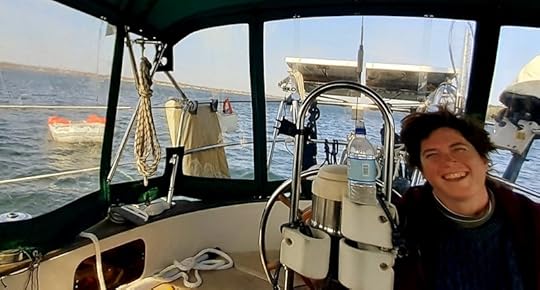
The weather didn’t stay mild for long, being as though it’s that kind of spring. The weather system heading our way today is almost as severe as the one that sent us to the dock last week (was that last week? time is strange right now…) but we’re more comfortable being at anchor at the park than when we were across the channel next to the mooring field.
Rather than use minimum safe scope in order to be close to the dinghy dock, we parked her a little farther away but in a place with a ton of room. In the chart image below, the boat is the red arrow and the yellow circles with anchors are marks we made when we anchored.

So here we sit in another sheltered cove at 15:1, all by ourselves, warm and cozy with the fire blazing in another New England gale…
In Somnium.




